Candida albicans: dangerous fungus or harmless roommate?
If you suspect you are suffering from an infestation with the yeast "Candida", then be sure to read this article.
Because you get:
☑️ A free online test, with which you can check whether Candida is in your Body is located
☑️ Exclusive scientific knowledge about the mushroom, which you will otherwise not find on the Internet (Latest research results 2021)
☑️ In-depth information on how you can remove the candida fungus from your body self-treatment be able
☑️ Scientific evidence that the yeast under certain conditions very dangerous for the Health can be
☑️ Tips for the correct nutrition in case of an infestation with Candida albicans
Let's start with the question:
What is Candida Albicans?
First of all, 4 fact
1. Literally translated, Candida albicans means “white yeast“. [1]
2. It occurs in 70% of people in the digestive tract, on the mucous membranes of the mouth and throat, and in the genital area. [2]
3. Candida albicans is a natural member of the microbiome, but certain conditions lead to excessive propagation and mutation. Then Candida suddenly becomes dangerous. In addition to various complaints, there may even be an infectious disease called candidiasis. [3]
4. In medicine, a distinction is made between mucocutaneous candidiasis, i.e. an infection that only affects skin and mucous membranes, and a so-called systemic infection, which also affects other tissues and organs. [4]
It continues with the questions: Where does Candida live? What is it doing? And ... does it harm your health?
Candida in the body
In addition 4 more facts
1. Candida does not need oxygen to live. The optimal location is therefore the small intestine. This is why yeast causes digestive problems in many people. [5]
2. The mushrooms swim in the intestine, well nourished and under optimal conditions in the food pulp. You rob here always important nutrients, such as vitamins, minerals and trace elements. [6] Thus, the harmless Candida variant is also a Parasit and harms people.
3. Optimally supplied, Candida yeasts can double within 20 minutes. [7] That explains the rapid spread. The main growth factors are sugar and alcohol.
4. The protrusions of the villi offer excellent hiding places and the parasites usually form small nests there. [8]
It continues with the question: Is Candida always just a harmless part of our body or a poisonous pathogen?
How Bad is Candida?
Candida yeasts are basically spherical in shape. In this they are nothing but a relatively harmless roommate who feed on the food pulp in the intestine. [9]
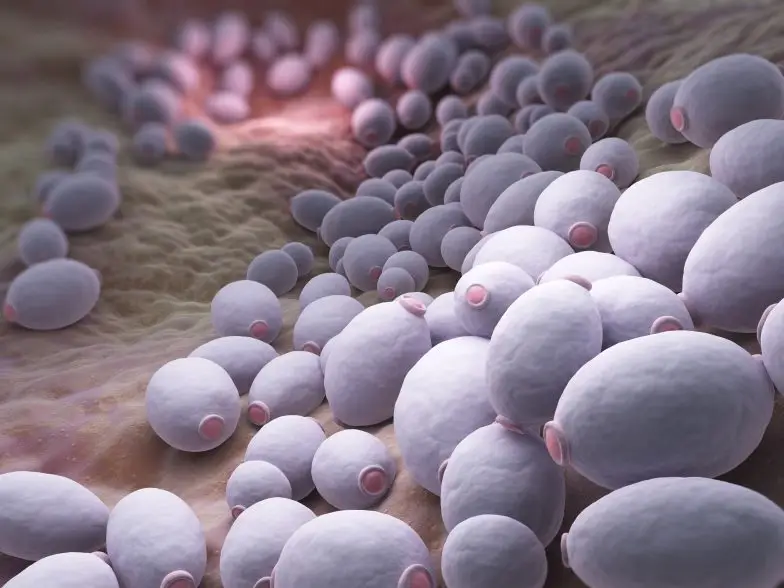
That changes, however, if one or more of the following requirements are met:
2. Immunodeficiency
3. Imbalance of the intestinal flora
Then the yeast turns into a thread shape. In this it can break through tissue (invasion) and colonize all organs of the body. One speaks of a systemic Candida infestation. [10]

Dangerous: Candida in thread form
In the thread form it is not only invasive, but also significantly dangerous. This can have serious consequences for your health.
The yeast will establish itself in organs and defend its place of life vehemently. [11] In doing so, they harm the body in a dramatic way. Because in addition to the withdrawal of nutrients from the blood and organs, Candida in thread form permanently releases strong toxins, so-called mycotoxins. [12]
In this way, they inhibit, among other things, the local immune system of the affected organs. They prevent the body from building special immune cells against pathogens (so-called T lymphocytes). The fungus itself, but also other parasites have it easy to spread. A vicious circle begins. [13]
Attention!
Mycotoxins are extremely resistant. Neither heat up to 160 ° C nor acids can harm them. With the fungus poison Candidalysin, Candida eats holes in the outer skin of cells. They can then from parasites and viruses be taken. [14] Researchers from Kings College London and the Borstel Research Center found out that the poison bears astonishing resemblance to the bee venom Melittin. Candida toxins can also cause permeability of the intestine can be triggered. That can lead to autoimmune diseases, allergies, food intolerances and other diseases. [15]
How do parasites ensure that Candida albicans becomes thread-like and therefore dangerous?
Via 5 different mechanisms:
1. Parasites (worms, leeches, protozoa …) reduce the body’s defenses. Find out more An intact immune system can prevent the transition into thread form .
2. They eat good bacteria in the intestines. This leads to an over-settlement. Find out more Positive intestinal bacteria can also prevent the mutation.
3. Parasites release toxins into the body that can cause the candida to mutate. Learn more
4. They eat a large amount of important nutrients that can prevent the transition into the dangerous form. Learn more
5. Candida fungi live in and on parasites and are protected by them (e.g. from drugs or the body’s defenses). Find out more They are also used to spread them in the body.
Digression
Researchers found that parasites are able to manipulate the immune system in such a way that pathogenic fungi such as candida can spread throughout the body.
The parasite test
The first and most important step to curing a Candida infestation is now to check whether you might be suffering from a parasite infestation without knowing it. We recommend that you now carry out our free online parasite test:
Important! The Parasite Academy
If you are hearing about parasites for the first time or you are not yet familiar with the subject, we recommend our free video course “The Parasite Academy”. There you can find out everything you need to know about parasites in humans in short, compressed videos.
The Meta Study
Do you prefer to read? Then we recommend that you find out more about the topic in our large meta-study. There you will really learn everything about “Parasites in humans” summarized on one page.
Symptoms of Candida Infestation
An excessive increase in thread-like Candida albicans can lead to the following health problems: [16]
- acne
- Allergies
- Bloated stomach
- Rash
- Food cravings
- Itching at the anus
- headache
- Short breath and heart problems
- Menstrual Problems
- Fatigue
- Muscle pain
- stomach pain
- Diarrhea
- Vaginal fungus/penis fungus
- Obesity
- Digestive problems
- White coating on the tongue
Diagnosis of pathogenic infection with Candida albicans
The self-test
To find out whether you could be affected, you can carry out our free online test.
Simply answer the questions asked now. You will immediately receive your result:
1 I have digestive problems, i.e. diarrhea, constipation or both alternately
2 I am often exhausted and exhausted
3 My tongue is coated and not pink
4 I often break out in sweats
5 I have mood swings for no apparent cause
6 I am overweight and have problems losing weight
7 Despite good dental hygiene, I suffer from bad breath
8 I have recurrent bladder or vaginal infections
9 I suffer from muscle and joint pain
10 I have a bloated stomach, especially after eating
11 I have food intolerances
12 I suffer from itchy anus
13 I suffer from insomnia
14 I often get sick and am prone to infections
15 I suffer from allergies (e.g. hay fever)
16 I suffer from a major illness (e.g. psoriasis)
17 I have trickling dandruff
18 My scalp is itchy
19 I have eczema on my face or other parts of my body, e.g. in the crook of my arm
20 I smoke or drink alcohol
21 I eat carbohydrates and sugar a lot
22 I have had to take antibiotics several times in my life
23 I suffer from food cravings
24 I have had a nail or athlete's foot before
25 I have diabetes
26 I've used cortisone several times
27 I take birth control pills or other hormonal drugs
28 I have tooth decay
The saliva test
A fungal attack in the mouth is often recognizable with the naked eye. A smear is taken with a solid, sterile object. The doctor has to scratch the object vigorously over the tongue, palate and gums. The mass is then examined in the laboratory.
Transmission and Contagion
How do you get candida? On the trail of the cause…
Important!
Regardless of what the infection comes from, a healthy body will simply be able to kill the pathogen. For example, if parasites in the body, Candida can become lodged. Because parasites reduce the immune performance and inhibit positive intestinal bacteria that are able to defend themselves against pathogens.
About animals
Yeasts that cause disease do not occur in nature, as they are dependent on a living being. The cause of a Candida infection can be transmission from animals such as dogs, cats or horses. Eating contaminated meat and fish can also lead to infection. [17]
From human to human
But other people are also contagious. A French kiss can be enough. Starting from the mouth, the mushrooms then spread throughout the digestive tract. Transmission also takes place via sexual contact. So Candida is contagious. [18]
memory!
A sugary, unbalanced diet can cause Candida albicans to multiply rapidly and thus cause candidiasis. [19]
Treatment and therapy of an infestation with Candida albicans
A fungal infection can only be treated successfully (sustainably) if the caused for a pathogenic Candida infestation is eliminated. So a harmonization of the body environment is created.
In our experience, the means of choice is one Parasitenkur. Because with this you can achieve both short-term relief and sustainable healing success. It lies
1. Systemic control of Candida albicans, i.e. in all organs. It does this by taking home remedies, performing applications, and adjusting diet. By containing the infestation, the immune system is relieved.
2. Fighting parasites, which leads to it
– the immune system is strengthened
– the microbiome in the intestine is harmonized
– there are fewer toxins in the circulation
– Your body has more nutrients available
– they can no longer protect and spread the fungus in themselves
This can deprive the fungus of its livelihood. He then switches from the Thread shape in the harmless Spherical shape.
All described here causes for a pathogenic spread of candida be carried out with a Parasite cure also eliminated. Permanent freedom from the yeast is possible.
Without removing Parasites from the body in our experience there is no chance of getting the candida under control. Because the body environment is always kept “Candida-friendly” by parasites.
Our experience is that the Candida regresses after a parasite cure and the new body environment makes a renewed infestation impossible.
If you want to know how a parasite cleanse works, take a look at our guide now:
Not sure if you have an undetected parasite infestation?
Have it tested online for free:
Caution!
Medicines restrict the fungus briefly in its growth, but its breeding ground continues. It is not a causal solution. Yeasts can also develop resistance against the antimycotics (anti-fungal drugs) often prescribed by doctors. In addition, candida protects itself from drugs in parasites. Candida yeasts are now the fourth most common pathogen in hospitals. [20]
Adjustment of the diet (diet) in case of Candida infestation
Important! In advance…
A change in diet without causal treatment can never lead to the relief of a Candida infestation. But nutrition is part of therapy. Better not to try to defeat candida with diet. Nutrition can only prevent and support.
And beware! Do not fast! No intermittent fasting either! Hungry mushrooms can be very dangerous as they eat their way through intestinal walls and use the sugar in the blood as food. In addition, they produce more mushroom toxins to keep eating competitors away. [21]
The rules of nutrition
You should eat this
– erythritol
– Stevia
– Fermented food (e.g. kimchi or sauerkraut)
– Green vegetables (organic)
– meat (organic)
– fish (organic)
– Dairy products (organic) (e.g. yogurt, quark, cheese)
– pumpkin
– carrots
– Potatoes
– Quinoa
– Berry
– avocados
– lemon
– guava
You should avoid that
– table sugar
– xylitol
– Sweeteners with aspartame
– Fruit rich in sugar (e.g. dates, bananas, grapes)
– rice
– pasta
– Loaf
– alcohol
– mold cheese
How long should this diet be maintained?
Even if you eat the “Candida diet” forever, a systemic infestation will not be regulated through diet alone.
In association with a causal treatment should the diet be about must be adhered to for 6 weeks.
Atopic dermatitis from Candida?
In neurodermatitis, the organism fights the fungi that already colonize the organs. The body tries to transport the mycelium and dispose of it via the shortest route. The fungi are excreted in lymph fluid through the skin, intestines, vagina, tonsils, mouth and/or nose. Ointments treat neurodermatitis not causally, but only clog the pores. [22]
We recommend one causal treatment.
Candida in the intestines
70 percent of all healthy adults have fungi in their intestines. The most common types of intestinal fungi are Candida. In patients with disturbed intestinal flora (often through Parasiten) or weakened intestinal barrier can fungal populations enter the bloodstream and get in other organs of the body to distribute.
Intestinal candida dangerous to life?
Candida albicans is a facultative fungal pathogen that takes advantage of the weakened condition of the body and the immune system. Both superficial and life-threatening infections can occur in humans.
Morphological change
During a mucosal infection, Candida albicans undergoes a morphological transition from yeast to invasive thread hyphae. This change makes detection by immune defense cells more difficult. [23]
Candida in the intestines: the symptoms
If candidiasis of the intestinal mucosa is present, the following symptoms can occur: [24]
- Coated tongue
- Flatulence
- Diarrhea
- Migraines and tension headaches
- Fatigue
- Heartburn
- Digestive discomfort
- Feeling full
You can find out whether you have Candida in your intestines using our free online test:
For candidiasis of the intestine, we recommend one causal treatment.
Candida in the mouth: the characteristics
If Candida attacks the oral cavity, a burning inflammation can develop there. Doctors then speak of the so-called oral thrush. [25]
In addition to the tongue, the cheek mucosa, the throat and the soft and hard palate can also be affected. In some cases, the infection also spreads to the esophagus. [26]
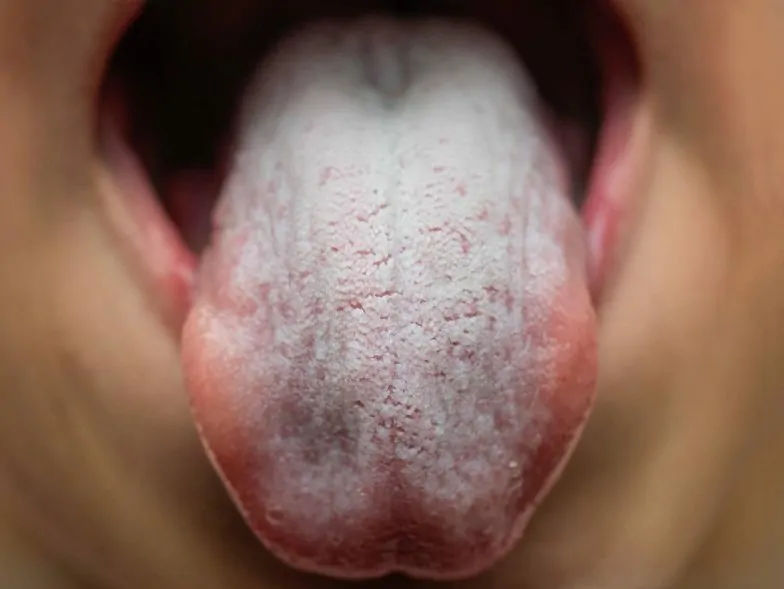
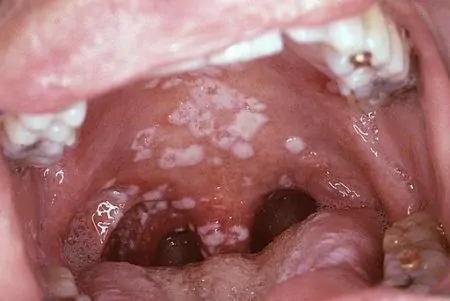
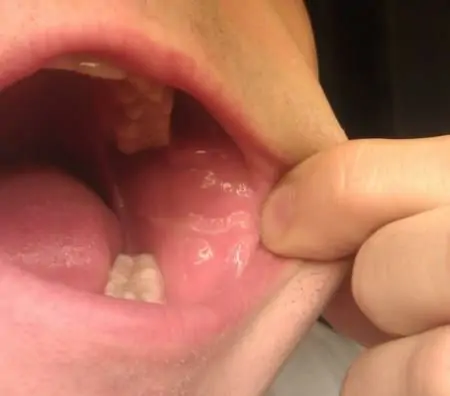
Symptoms of Candida in the Mouth
A whitish coating develops on the reddened mucous membrane which can be wiped off with a little pressure. However, this often leads to bleeding and is therefore not recommended. It should be one original treatment be performed.
With involvement of the esophagus, those affected often complain about pain when swallowing or a burning sensation behind the breastbone.
The symptoms of oral candidiasis are: [27]
– redness
– white coverings
– bad breath
Warning!
If the mouth is already affected, it is a so-called systemic infection. We recommend one causal treatment.
You can find out whether your symptoms are actually Candida using our free online test:
Candida on the skin and face
Candidiasis of the skin primarily affects the intertriginous regions of the body [28], also:
– Afford
– belly folds
– Area below the female breast
– Gaps between fingers and toes
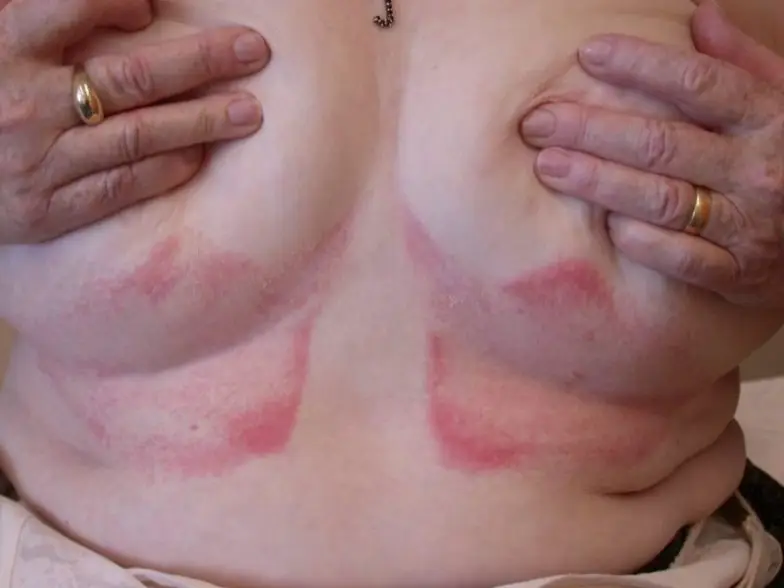
Only rarely is the face affected, i.e. the nose or eyes.
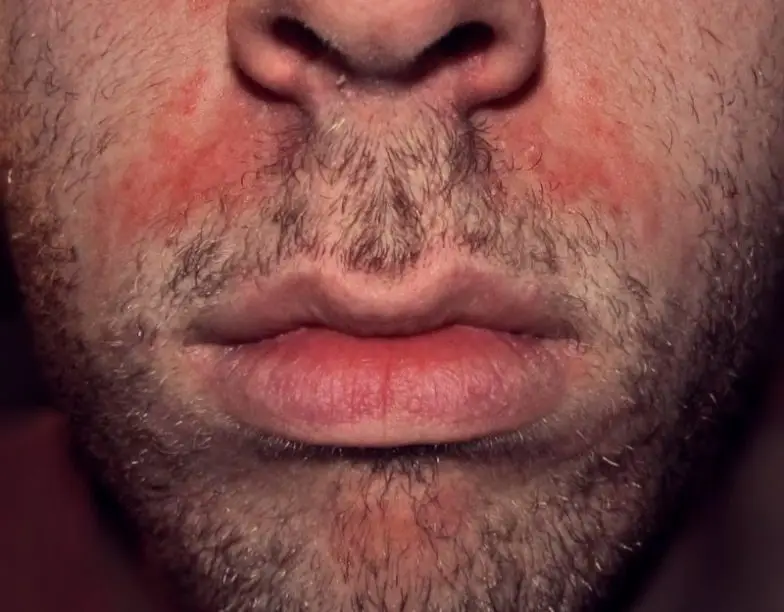
A Candida infection of the skin is favored by a humid and warm environment. For example under the armpit, at the corner of the mouth, on the lips, under the chest or between the fingers.
Symptoms of candidiasis of the skin
A disease can be identified by:
- Itching
- weeping skin changes
- Redness
- painful skin tears
- whitish, flaky edge at the transition to healthy skin
You can find out whether it is actually Candida using our free Candida online test:
If the skin is already affected, there is one systemic infestation with the mushroom. We recommend one causal treatment
Candida Infestation of the Penis: Symptoms and Features
An infection of the genital area in men can be recognized by whitish coatings on the foreskin and the glans. [29]
Pain and burning of the penis can also occur. [30]
Transmission and Contagion
The penis fungus can be transmitted during unprotected sexual intercourse. In doing so, it gets into the flora of the genital mucous membrane, the germ balance is upset and infection occurs. [31]
Often this happens in phases of stress. Or even if the immune system (e.g. through Parasiten) is battered. [32]
A narrowing of the foreskin or poor hygiene favor the infestation. [33]
Candida infection of the vagina (vagina)
Normally, the mucous membrane has a acidic environment for natural protection against infections. If the vaginal bacterial flora is out of balance, it can lead to candidiasis, i.e. a vaginal yeast infection of the vagina. [34]
This manifests itself with the following symptoms [35]
- Burn
- Redness in the genital area
- Pain during intercourse
- painful urination
- severe itching in the genital region
- whitish-crumbly discharge
As a first aid measure to contain the fungus and to alleviate the unpleasant discomfort, creams and vaginal tablets are available in the pharmacy without a prescription. [36]
However, this does not represent a causal treatment (and sustainable) because the breeding ground remains and Candida albicans can spread again at any time. In addition, yeasts are increasingly resistant to antifungal drugs. [37]
We therefore recommend one causal treatment.
FAQ: Frequently asked questions about "Candida albicans" answered by experts
The typical symptoms of a fungal attack can be treated with globules.
There has been good experience with Kalium sulfuricum in the potency 6X to 12X or Candida albicans 30C. The immune system can also be supported homeopathically with Schüßler salts. Naturopathic doctors recommend salt no.6.
The effect of homeopathy is not about relieving the body of the work, but supporting it in its natural activities. [38]
One causal therapy however, homeopathy cannot replace it.
It can have a positive effect on the regulation of the intestinal flora. Apple cider vinegar is also able to reduce germs and promote good intestinal bacteria.
That is why apple cider vinegar can be used as an accompaniment to one causal therapy can be used.
Antibiotics favor fungal infections because, according to a study by the Max Delbrück Center for Molecular Medicine (MDC) in Berlin, the microbiome needs at least six months to recover. [39]
In addition, every use of antibiotics releases macromolecules from the cell walls of intestinal bacteria and this promotes and intensifies the spread of Candida albicans. [40]
We recommend one instead of taking antibiotics causal therapy.
Baking soda is often recommended as a home remedy for candida. However, there are no studies or success reports on this. We advise against taking it, as the stomach acid alkalizes and this makes it easier for pathogenic agents (e.g. fungi and parasites) to enter the body.
We recommend one instead causal therapy.
The body’s reaction to the toxic metabolic products of the fungus can manifest itself in muscle and joint pain. In this case one already seems systemic infestation to be present.
We recommend one causal therapy.
In women, candida can cause vaginal mycosis, a fungal infection of the genital area.
Typical symptoms are redness and swelling of the genital area and a creamy to crumbly discharge. In addition, there may be a burning sensation and pain during sexual intercourse.
In men, the disease manifests itself as reddening of the foreskin and glans. Often the inner parts of the foreskin are swollen. These symptoms are accompanied by itching, burning and pain.
Antifungal drugs are prescribed for fungal treatment. They are supposed to inhibit the growth of the fungi or kill them. In the case of penis fungus, anti-fungal agents are applied externally in the form of ointments. However, Candida albicans is able to develop resistance to antimycotics. This can result in recurring infections.
That’s why we would always (also) be one causal treatment.
Yes, the fungus can spread on the skin and shows itself as oozing, itchy, reddened areas surrounded by whitish scales.
Frequently used active ingredients for the treatment of candidiasis are antimycotics.
Side effects of these agents are, for example, fever or headache, but also vomiting or stomach and intestinal problems. When treating with these agents, the elimination of fungal toxins is often completely disregarded. Therefore, a causal and systemic treatment. With this, the immune system and the healthy intestinal flora are sustainably strengthened.
Home remedies for Candida are:
– Colloidal Silver
– Apple Cider Vinegar
– Garlic
– coconut oil
– lactic acid bacteria
– aloe vera
As long as the Cause of infestation is not remedied, however, the ingestion cannot be effective in the long term.
Creams or ointments do not help causally, but only superficially. For example, when the fungus is externally visible. the Root cause however, it is systemic. This has to be fixed.
With a skin sample, skin is scraped off the affected area and then grown into a fungal culture, which a doctor examines with a microscope. The fungus can then be seen there. The same goes for a tongue swab.
A hemagglutination test looks for type M (IgM) immunoglobulins and can thus provide information about whether these antibodies are present in the blood and whether the body is defending itself against infection.
Various skin products are recommended e.g.
- Cinnamon
- Tea tree oil
- Coconut oil
- or garlic
The actual success of these remedies has not yet been proven. Besides, it’s not one causal solution.
A study from Taiwan found that the most common mycoses of the lungs are caused by Aspergillus or Cryptococcus neoformans, and thirdly, Candida. [42] one holistic parasite cure works against all three types of fungus.
Yes, because Candida albicans robs nutrients that are required for healthy hair and hair growth, for example. For example zinc, copper, selenium or vitamin C. There is no need to take food supplements, as the fungus removes the nutrients anyway. One holistic treatment is expedient here.
For an initial assessment, you can use our Online candidate test carry out. You can get a diagnosis from your doctor.
Yes, mushrooms multiply rapidly under favorable conditions. A small sample is sufficient to allow them to sprout on a suitable nutrient medium in the special laboratory.
Yes, because fungi displace the bacteria in the natural intestinal flora, many patients suffer from constipation. [43]
We recommend causal treatment. Read hier how it goes.
Mouth and diaper thrush occur more frequently in babies, as the skin colonization with healthy germs is not yet fully developed. Gentle homeopathic treatment with ratanhia, myrrh tinctures, Mercurius solubilis or potassium chloratum Globuli 6X is recommended.
Probiotics can support the healthy intestinal flora.
Special lactobacilli have been used successfully for gynecological candida infections for a long time. The physician Prof. Dr. Martin Schaller and his team at the University Dermatology Clinic in Tübingen researched the connection between probiotics and Candida. They found that inflammatory reactions can be mitigated with the help of probiotics, but the researchers have ruled out that lactobacilli are able to directly inhibit the growth of Candida. [44]
Be sure that you do the probiotics before taking the Parasites from the intestines remove. Because these eat up the probiotic bacteria.
Yes, Candida is one of the yeasts and these are known to “open”.
Flatulence and bloating can be an indication of a candida infection. If you want an accurate assessment of whether you are affected, we recommend ours Candidate Online-Test.
Candidiasis can become a serious problem in cancer patients, especially those who have undergone intensive chemotherapy, thermotherapy, or bone marrow transplants and who have a weakened immune system. Candida then develops on a massive scale. [45]
Candida can also cause cancer directly. Their poisons puncture cells. Parasites can then board them and cause the cell to degenerate. [46]
The natural sulfur compound can possibly support a healthy intestinal flora because of environmental toxins like heavy metals, drug residues and chemical residues
the body and fungi occur in correlation with these loads.
Be careful before taking any Parasites from the intestines to remove.
About 30 percent of all pregnant women are affected by vaginal yeast infections. The hormonal changes favor the growth of yeast fungi.
The direct change in the vaginal environment caused by candidiasis can help potentially dangerous germs multiply more easily. If yeast is detected during the last trimester, antifungal therapy is recommended to prevent oral thrush and diaper rash in newborns.
The “Université de Montréal” warned in a press release that oral intake of certain antifungal drugs appears to increase the risk of miscarriages. [48]
We therefore recommend a causal treatment.
Fungi can be involved in the development of allergies in a variety of ways. The parasites constantly irritate the immune system. Asthmatics or pollen allergy sufferers often suffer from fungus in the airways without knowing it. Your airways are damaged and the immune defense in the lungs is inhibited. If cortisone sprays are then also used, this also promotes fungal growth. [49]
We recommend one causal treatment.
Onions, garlic and leeks belong to the lily family and contain a particularly large number of phytochemicals that have been proven to be effective against pathogenic fungi. Sauerkraut is also one of the enemies of mushrooms. The lactic acid bacteria contained support the good intestinal bacteria. In addition, the vitamin C it contains promotes our immune system. Sugar and other carbohydrates such as grain or rice should be avoided. It is essential to avoid alcohol (also a sugar).
However, nutrition can only have a preventive or supportive function. One is indexed causal treatment.
- White bread
- Toast
- Buns
- Yeast pastries
- Jam
- honey
- Sugar
- Alcohol
All real mushroom food.
Baker’s yeast promotes Candida. Therefore, bread with this ingredient should not be consumed. Sourdough bread made from whole wheat flour is best.
During a 2-week, strict diet phase, you should avoid all foods with sugar or fine flour, as well as alcohol. This should include a causal treatment be performed.

